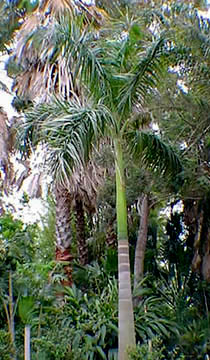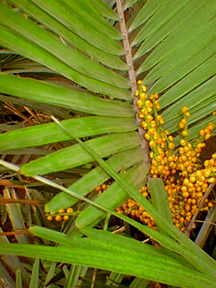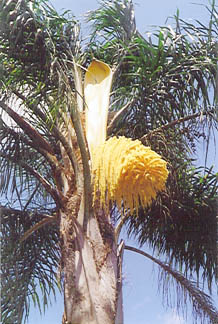

The palms
This is a feature that the Rio Grande valley can be proud of. The Texas Riviera is truly the land of palms. Palms line our highways throughout south Texas and it is difficult to find places in the lower valley where palms cannot be seen in every direction. The palms in "Mango's Jungle" have grown exceeding well. Some of the original Mexican fan palms are now over 40 feet tall. Massive palm leaves are everywhere in the garden some extending to the length of 20 feet or more. Fan shaped leaves (palmate) are in the majority and give a formal aspect. Feather type leaves (pinnate) have the longest fronds, generally, and add informality and are festive and relaxed. Many palms appear soft with a floating foliage that you cannot resist to touch. Others are armed and forbidding. The armed palms have hooks, spines, and thorns of various lengths and widths. Other palms have trunks which are full of hair, clean, thatched, or covered with burlap type coverings. They may be single trunked or clumping with many trunks. They may be tall trees or short little plants even when mature, barely tall enough to be called a shrub. They may resemble the tails of fish or fox, or they may look like bamboo. The variety is endless.
These are Thad's favorite plants. When he was young, he was fascinated with the palm leaves which were readily handed out on Palm Sunday, and he would think of far away places and wonder how his church could afford to purchase these exotic leaves all green and pretty, just knowing that these palms must be rare. Little did he know that vast numbers of many varieties existed and that large areas of the world are covered in palms. He is now able to live surrounded with these beautiful, massive leaves.
One of his favorite palms is the native Texas sabal (Sabal mexicana). The fan shaped leaves are huge. The boots (section of the leaf attached to the trunk) remains long after the leaf has been removed. These generally are green when the leaf is removed but after a few years, the boots become grey and later will fall off of the trunk. The fruit is especially appreciated by us macaws.
Another gorgeous palm is the royal palm (Roystonea oleracea). This one really doesn't belong in Texas since it freezes with a minimum of frost, but it is so beautiful that Thad has grown one. It has a large green crownshaft (leaf base) which is situated above a solid grey trunk which appears to be poured concrete. The leaves are pinnate and seem to float in the breeze. It is the most admired palm in Mangos Jungle and has been photographed many times.



Queen palms (Syagrus romanzoffiana) are also lovely. Several of the Queen palms are huge with trunks clean and grey. These palms have fronds of 18 to 25 feet in length, and they have one of the largest seed pods, an attraction that many guests take home as souvenirs. Other palms of note are the Fishtail palm (Caryota urens) and the foxtail palm (Wodyetia bifurcata). The Arenga engleri is a clumper that is large and dominates the view from our dining room window. Livistonas are common throughout the yard. The species include chinensis, drudei, decipiens, and a small saribus. These are fan palms, each with its own character and vitality. Several have drooping fronds that are extremely attractive.

Phoenix species include the date palm (dactylifera), the Canary Island date (canariensis), the pygmy date (roebelenii), and the Senegal date (reclinata). These are all pinnate palms and dangerously armed with vicious spines. I hate these palms since a macaw could get hurt flying in there. Most are from Africa or Asia and have a large range from small to tall palms.
Smaller palms are scattered throughout consisting of palms from Africa, Asia, Australia, South America, the Orient, the Caribbean, and or course, the southern United States. The bamboo palm (Chamaedorea radicalis), the lady palm (Rhapis humilis), the Mediterranean fan palm (Chamaerops humilis), and the metallic palm (Chamaedorea metallica) are all smaller under-story plants. The metallic palm is bluish green with a real metallic look. A spindle palm (Hyophorbe verschaffeltii) will develop its characteristic trunk which is narrow at the bottom, narrow at the top, and a large bulge in the center reminiscent of a top. The palms include varieties which are used in the manufacture of medicine (Serenoa repens), food (Butia capitata), (Phoenix dactylifera), and wine (Arenga pinnata), (Caryota urens). Note: Due to the primitive nature of Thad's lifestyle, he has not utilized any of these plants for medicine or wine. He prefers to purchase his medicine in Mexico and his wine at the local grocery store.
Besides these useful products, palms have construction uses. Various palm fronds were used to roof the palapa and my bird pen. Objects of art are also practical. Jungle masks, which decorate the yard, have been made from the boots of the queen palm. Future roofs and other palm features are planned using various parts of the palms for building material.